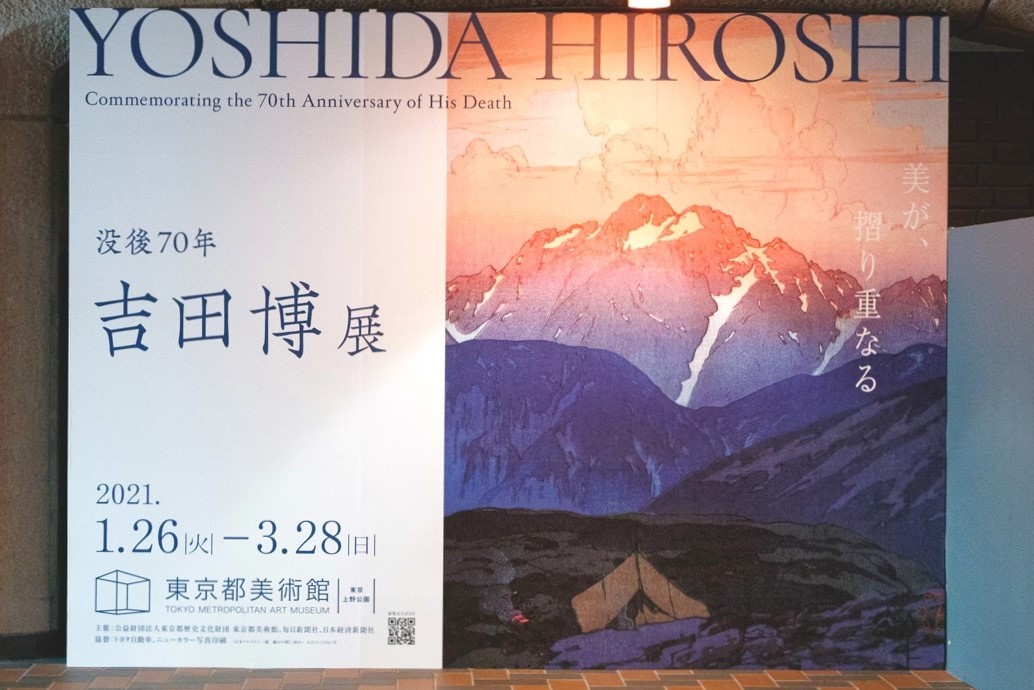
From January 26, 2021, a special exhibition "70 years after his death, Hiroshi Yoshida Exhibition " is being held at the Tokyo Metropolitan Art Museum in Ueno, Tokyo . (The session is until March 28th)
Hiroshi Yoshida (1876-1950), a painter who was active as a leading figure in landscape painting from the Meiji era to the Showa era, with high descriptive power acquired through studying to the extent that he was described as a "demon of painting".
While demonstrating his talent in watercolor and oil painting, in the latter half of the painting industry, he pioneered a completely new world of woodblock prints by combining Western realistic styles with traditional Japanese print techniques. It was loved by people all over the world, including Princess Diana of England and Freud, a psychiatrist.
In this article, we will introduce the exhibition contents and highlights of the "70 Years After Death Hiroshi Yoshida Exhibition", which is a collection of about 200 works, focusing on woodblock prints from the early days of Hiroshi Yoshida to his later years.
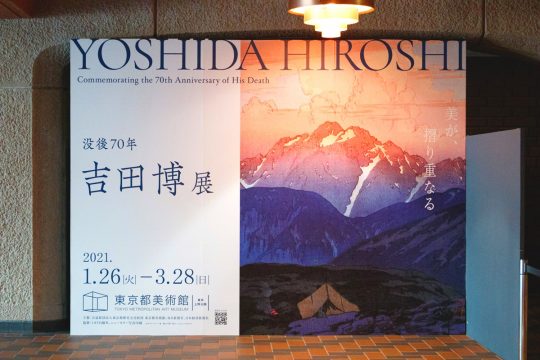
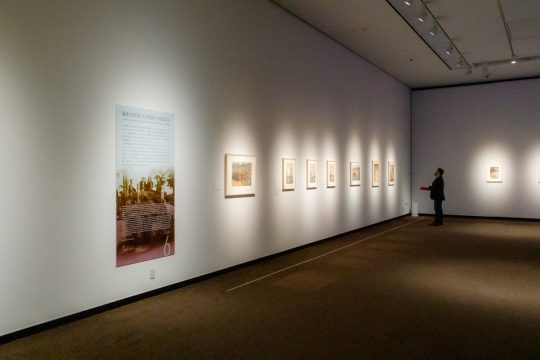
Exhibition scenery
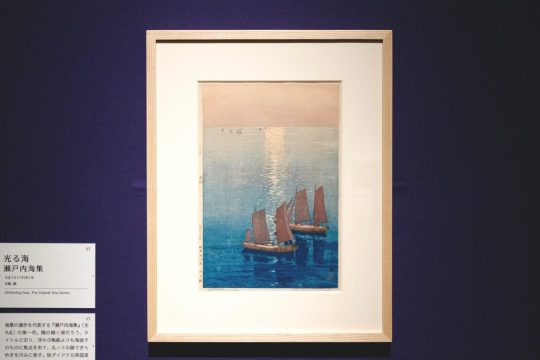
《Seto Inland Sea Collection Shining Sea》 1926 / A work known to have been displayed in the office of the late Princess Diana.
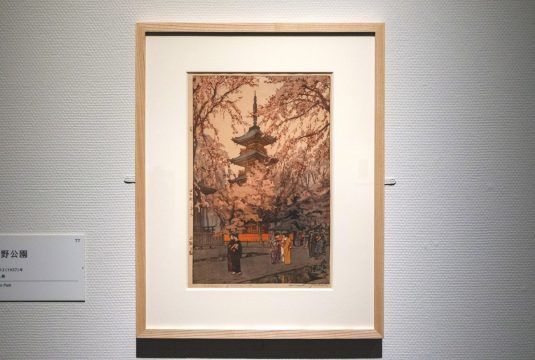
"Ueno Park" 1938 / A work based on Ueno Park, where the Tokyo Metropolitan Art Museum is located.
* The exhibition period is divided into the first half (January 26th to February 28th) and the second half (March 2nd to March 28th) , and some of the exhibited works will be replaced . This article focuses on works that can be viewed during the first half of the year.
* Works without a period notation in the image are on display for the entire period.
Hiroshi Yoshida's woodblock prints that fascinated the world
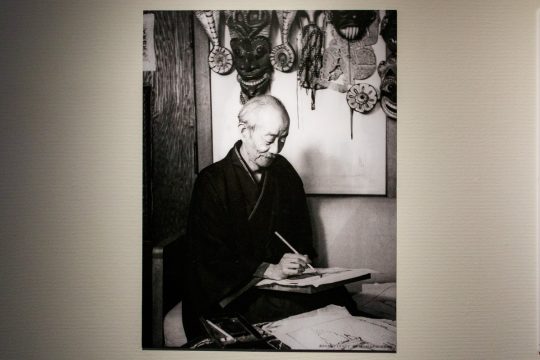
Hiroshi Yoshida
Hiroshi Yoshida, who had the belief that "the true nature can be drawn only by immersing himself in nature and becoming a sacrum (= the state of the hermit)", jumped into nature from a young age with a thorough field principle. , I was absorbed in landscape photography and rigorously refined my technique.
In 1899, 23-year-old Hiroshi chose America as a place of challenge instead of France, where many Japanese painters studied abroad at that time, and set out with as much of his own paintings as possible. Hiroshi's work, which contains Japanese lyric nuances, fascinates the hearts of Americans. The solo exhibitions held locally were very successful one after another.
Hiroshi, who made a name for himself in the field of watercolors and oil paintings, began to work on woodblock prints in earnest after he was in his mid-40s. It is said that in 1923, when he visited the United States for the third time, he witnessed the local people seeking all the woodblock prints of mixed boulders rather than oil paintings.
After returning to Japan, Hiroshi immediately started making woodblock prints. At that time, the idea is to combine traditional ukiyo-e printmaking techniques with Western realistic depictions. The color coding and composition have also been devised in various ways that are not bound by tradition.
Then, we challenged the oversized prints, sometimes rubbed them nearly 100 times, and used the same woodblock to change the color to express the state of light and atmosphere at different times. It expanded the world of original woodblock prints and was praised both at home and abroad.
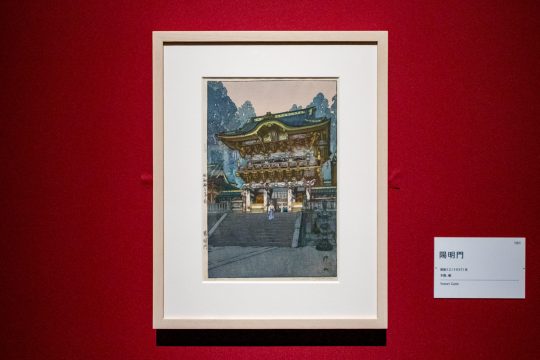
《Yomeimon》 1937 / The average number of ukiyo-e prints is about 10, but it was produced by an astonishing number of 96 strokes. The complex structure and age of the building are beautifully represented.
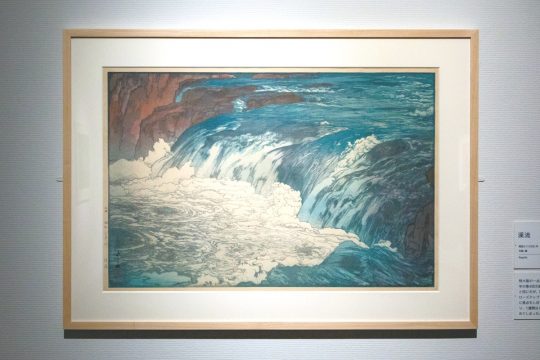
《Flow》 1928 / Length 54.5 x Width 82.8 cm. We are boldly working on oversized works that are difficult to produce because the larger the size, the more likely it is to shift.
Kobayashi, a curator of the Tokyo Metropolitan Art Museum, said, "I think what Hiroshi pursued with woodblock prints was to realize delicate color expressions of watercolors and oil paintings with prints." Mr.
After thoroughly studying the techniques of carving and rubbing, Hiroshi hired a tattooist and a tattooist to supervise all the work. Sometimes he was in charge of carving and rubbing himself. He compared himself to a conductor and an architect, and even in a complicated process where it was said that only the person could know how far it would be completed, he did not make any compromises in search of perfection.
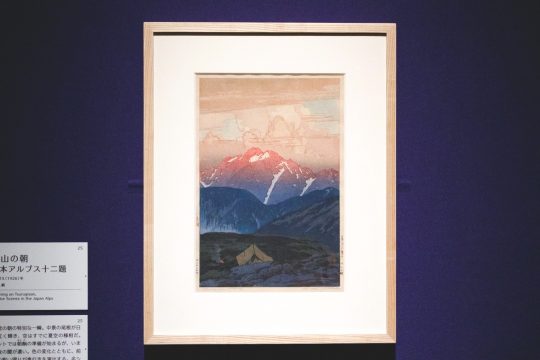
《Twelve titles of the Japanese Alps, Mt. Tsurugi Morning》 1926 / One of the famous masterpieces in the famous series “Twelve titles of the Japanese Alps”. The contrast between the mountains that turned red in the morning sun and the campsite where the darkness remains. The moment of dawn is expressed by the color gradation by the delicate rubbing.
Mr. Kobayashi continues like this. "Please pay attention to the light and atmosphere that can only be expressed by Hiroshi Yoshida, a Western-style painter with solid drawing power, and the delicate hue nuances unique to him."
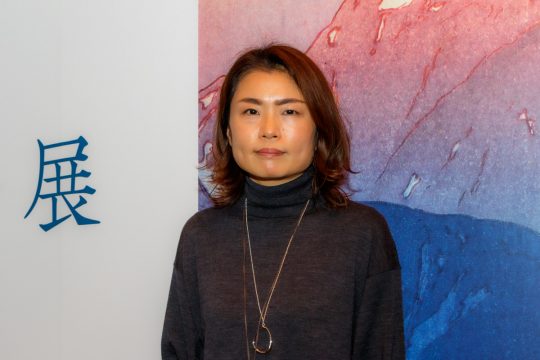
Mr. Kobayashi, a curator who guided us to the exhibition
Woodblock prints depicting landscapes from all over the world are in one place. Exhibition composition of "70 years after death Hiroshi Yoshida exhibition"
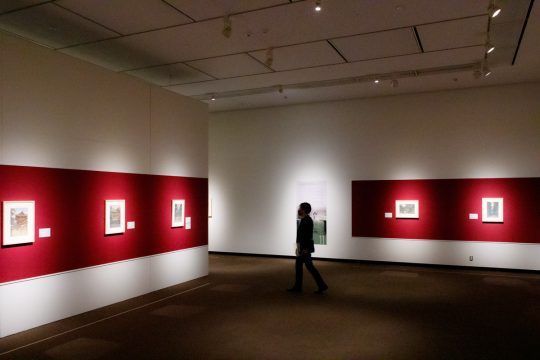
Exhibition scenery
This exhibition is organized to introduce Hiroshi Yoshida's works by theme according to a rough age, from Prologue to Chapter 1 to Chapter 11 to Epilogue.
Each chapter is composed of various themes such as landscapes of the United States and Europe, mountains of Mt. Fuji and Japan, landscapes of various parts of Japan, landscapes of India and Southeast Asia, and landscapes of Korea and the former Manchuria. Since there are many works, it is a good idea to secure enough viewing time.
The main exhibited works are woodblock prints, but in the prologue, you can also appreciate typical oil paintings and watercolors in order to look back on the history of the exhibition until you worked on woodblock prints.
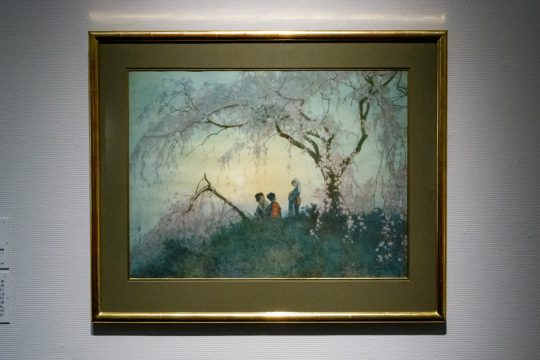
《Sakura Kumoi》 Around 1899 Watercolor, paper Fukuoka Prefectural Museum of Art Exhibition period: January 26-February 28

《Mountain Stream》 1910 Oil on canvas Fukui City Art Museum
A sketch book is also exhibited as a material. It seems that the woodblock prints were not always produced according to the composition of the sketch, but you can get a glimpse of what captured the eyes and spirit of Hiroshi.
Speaking of materials, pay attention to the fact that woodblock prints are exhibited. To understand the difficulty of carving and rubbing more frankly by comparing the main version (wooden block to show the outline) and the color version of "Fuji Pickup Asahi" on display with the finished work. Is done.
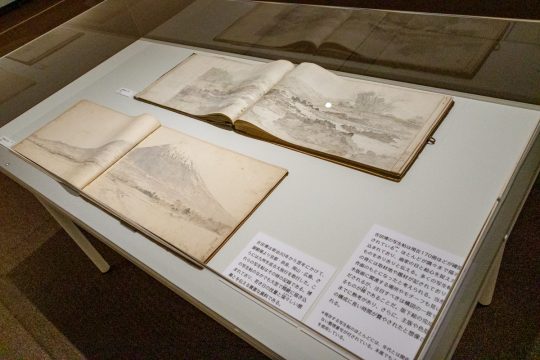
Sketchbook / The scenery of each place is drawn with pencil and watercolor, and you can feel the "genius of early drawing".
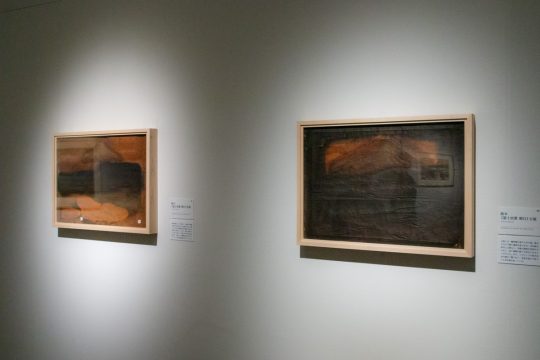
(Left) 《Fuji Pickup Asahi Color Edition》 (Right) 《Fuji Pickup Asahi Main Edition》 1926
There is also a video exhibition, one is a video that introduces the woodblock print production process, and the other is a video that briefly introduces the life of Hiroshi. In particular, the latter has a storytelling narration, so I enjoyed it in a very easy-to-understand manner.
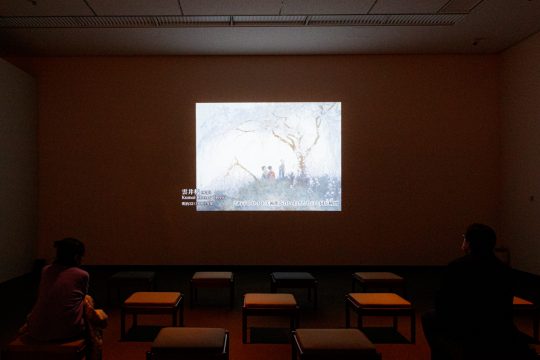
Video exhibition
Introducing featured works and highlights
As a Western-style painter living in Japan, Hiroshi Yoshida continued to search for what is an original "painting" that can compete with the world. The answer that came to the end of that pondering was woodblock prints. There are countless highlights, but here I will pick up and introduce the points that I found particularly wonderful.
Highlights ① Mountaineering landscape drawn from the perspective of a mountaineer

《European Series Jungfrau Mountain》 1925
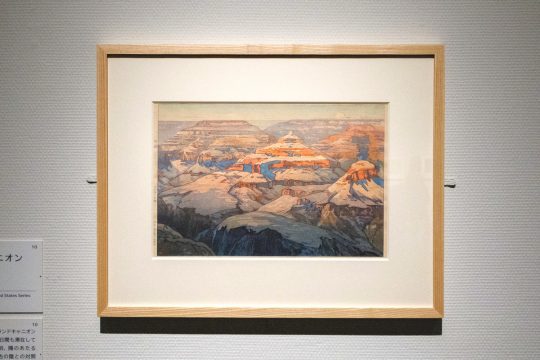
"US Series Grand Canyon" 1925
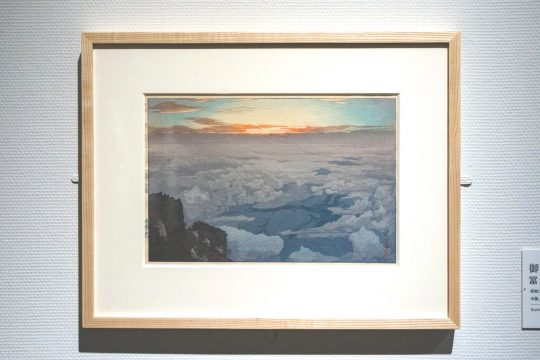
《Fuji Pickup Sunrise》 1928
Expo, who loved nature, was so interested in the mountains that he could spend his days in the mountains every summer. He is called a "mountain painter" or "mountain painter" because he has left many of the scenery he saw through full-scale mountain climbing in his works.
He climbed to the top of the mountain, confronted the mountains where the weather was changing, and camp for days until he was satisfied with the moment he wanted. The magnificent mountain scenery captured in this way is one of the best highlights of Hiroshi's work.
Above all, the composition overlooking the sea of clouds from the summit, such as "Fuji Picking Up Sunrise", can be said to be a remarkable achievement for mountain painters. The flowing clouds that created the exquisite gap and the sun that began to rise from the back were captured at the perfect timing, and the scenic appearance is beyond description. There is a mountain that is surrounded by silence that no one can invade.
Highlight (2) A work of "Separate" that skillfully expresses the change of time with colors

(Left) "European Series Sphinx Night" (Right) "European Series Sphinx" 1925
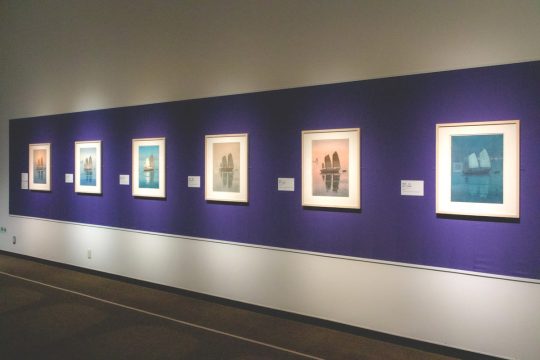
6 works of the "Seto Inland Sea Sailing Ship" series
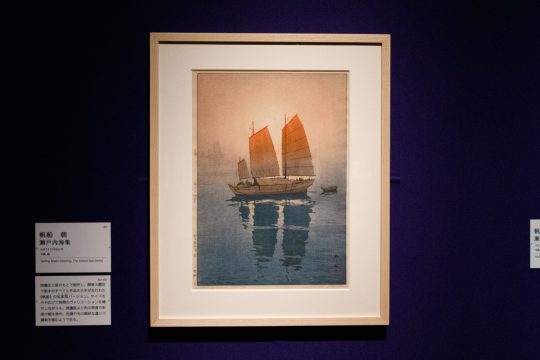
《Seto Inland Sea Sailing Ship Morning》 1926
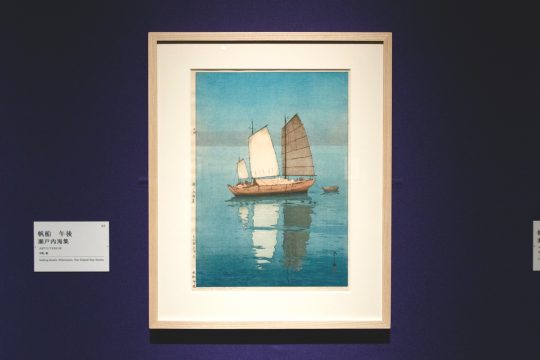
《Seto Inland Sea Sailing Ship Afternoon》 1926
Hiroshi used the technique of "separate sliding" to create works of different colors using the same woodblock, and expressed changes in the field of vision that change over time, such as "morning" and "night."
For example, in the "Seto Inland Sea Sailing Ship" series, which is one of Hiroshi's masterpieces, the same scene at different moments can be seen in "morning," "am," "afternoon," "fog," "evening," and "night." It is drawn, and the differences in light and atmosphere are depicted in color and expressively.
Don't think, "You just changed the color?" Only the sails of the "morning" sailing ship have a slight pattern added, perhaps playful. The silhouette of the ship drawn behind "evening" was not in "afternoon". At "night", the inside of the sailing ship and the background are lit, and so on. The more you compare, the more you will find small differences in detail, and you will never get tired of it.
"Morning" is especially beautiful. The morning sun is backlit, the outline of the sailing ship turns red, and the boundary between the sea and the sky is blurred by gradation, creating a fantastic atmosphere. If you look closely at the brilliance of the sun, which gives a soft impression, you can see that the colors are finely outlined in concentric circles.
In this way, please pay attention to the fact that even if it is a "separate slide", it takes a lot of effort one by one.
Highlight ③ Depiction of various lights
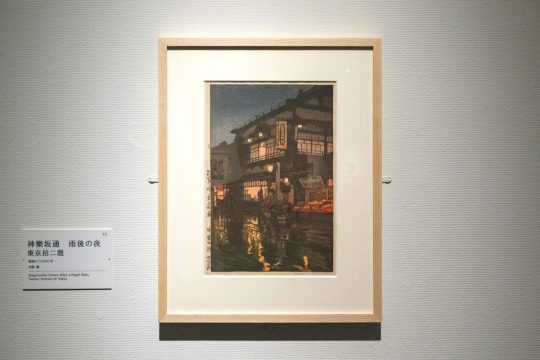
《Tokyo Pickup 2 Theme Kagurazaka Dori Night After the Rain》 1929

《India and Southeast Asia Fuwatepur Shikuri》 1931
As you watch the exhibited works, you can see that Hiroshi has an extraordinary passion for portraying light, but the atmosphere of light that is gently dropped into the darkness, such as the brilliant moon and the lights of lanterns. Has an indescribable charm.
Especially strong is the golden light that comes from the setting sun on the verge of setting.
The golden light that oozes from the Islamic architecture of Arabesque in "India and Southeast Asia Fuwatepur Shikuri" conveys the atmosphere of a foreign country.
It seems that pale similar colors were rubbed over and over again to express this diffuse reflection, but I have no idea how to stack the plates anymore, and it would be hard to believe that Hiroshi could use magic. Perhaps because the contours are suppressed, the beauty that makes you lose words gives the viewer the impression that you are looking into a world that is not in the world, as if you were floating somewhere in the air.
Highlight ④ Overshadowing of the water surface
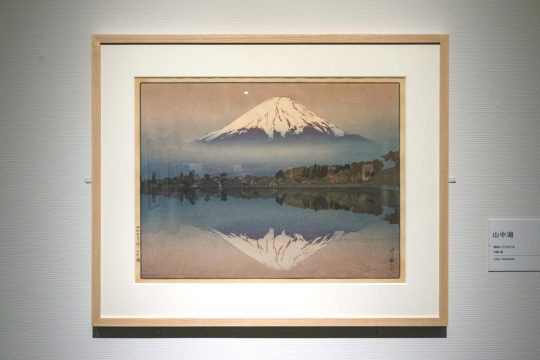
"Lake Yamanaka" 1929
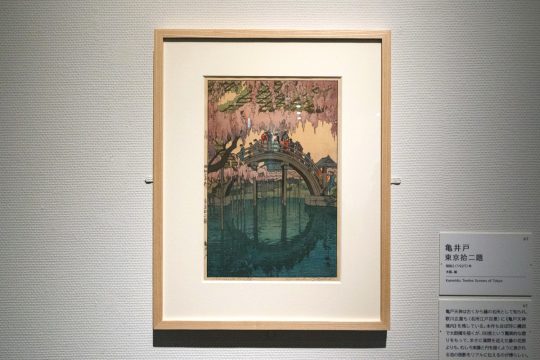
《Tokyo Pickup Two Titles Kameido》 1927
Various types of watersides appear in woodblock prints of the Expo, including the sea, rivers, ponds, lakes, and puddles. Landscapes and buildings are reflected on the surface of the water, and some of the works are such that the composition is completed only when there is the scenery reflected on the surface of the water.
The author groaned at the magnificent upside-down Mt. Fuji of "Lake Yamanaka" and the symmetry between the substance of the drum bridge and the shadow of the pond seen in "Tokyo Picking Two Kameido".
At first glance, the latter tends to look at the wisteria flower clusters that are in full bloom, but if you shift your gaze downwards, you may feel that you were more particular than the wisteria. Will take a look at. The composition that Taikobashi weaves with the shadow is strangely beautiful. Regardless of the truth, it seemed to me that "Hiroshi wanted to copy this into a picture." It is a work that expands the imagination of what the aesthetic sense of Hiroshi should be.
After being overwhelmed by the beauty of Hiroshi's woodblock prints, don't forget to check out the exhibition goods.
In addition to standard items such as framed posters and postcards, tote bags, A5 notebooks, ticket files, mask cases, furoshiki, coloring book sets, and chocolate Karinto as a variant, this exhibition's original that makes the most of the charm of Hiroshi Yoshida's work. Goods were also prepared.
Some of the catalogs and goods can be purchased at the online shop, and if you can't go to the exhibition, we recommend you to immerse yourself in the world of the exhibition with the official catalog (2,200 yen including tax).
<Online shop https://www.mainichi.store/categories/3121995 >
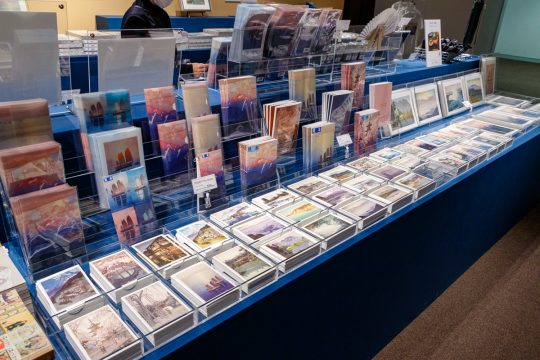
Exhibition goods section
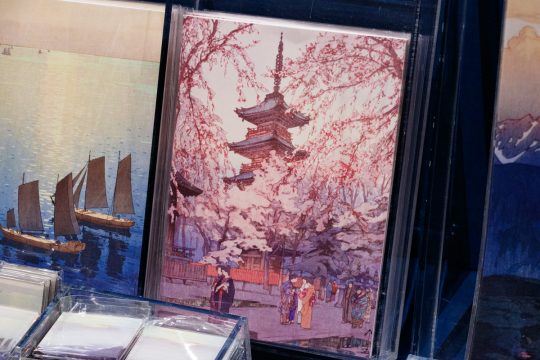
Some A5 notebooks are designed by "Ueno Park". It may be perfect for viewing commemoration.
From February 9th, Hiroshi Yoshida's prints exhibited at this exhibition, Hiroshi Yoshida's oil painting "Seika" in the Tokyo National Museum, and Kuroda Seiki, an artist of the same age as Hiroshi Yoshida. A free audio commentary program will be delivered to introduce the works of the Kuroda Memorial Museum, which is permanently exhibiting the works. You can listen to it on your smartphone, tablet, or PC, and you can enjoy a journey that follows in the footsteps of their art, whether at the venue or at home.
<Click here for details https://www.tobikan.jp/information/20210126_1.html >
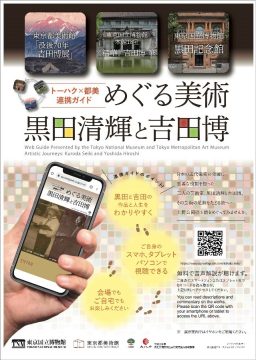
The Tokyo Metropolitan Art Museum "70 Years After Death Hiroshi Yoshida Exhibition" will be held until March 28, 2021.
Don't miss Hiroshi Yoshida's large-scale exhibition, which is becoming more and more popular year by year.
"70 years after his death Hiroshi Yoshida Exhibition"
| Session | January 26th (Tuesday) -March 28th (Sunday), 2021 * Some exhibitions will be changed during the exhibition period. |
| Venue | Tokyo Metropolitan Art Museum Planning Exhibition Room |
| Opening hours | 9:30 am to 5:30 pm (admission until 5 pm) |
| Closed days | every Monday |
| Admission fee | General 1,600 yen, university / vocational school students 1,300 yen, high school students 800 yen, 65 years old and over 1,000 yen * Free for junior high school students and younger (bring something that can be proved) * Persons with a physical disability certificate, love certificate, nursing certificate, mental disability certificate, health certificate for the atomic bomb survivor and their attendants (up to 1 person) are free of charge (bring a proof) |
| Organizer | Tokyo Metropolitan Art Museum, Mainichi Newspaper, Nihon Keizai Shimbun |
| Co-sponsored | Toyota Motor, new color photo printing |
| Official page | https://yoshida-exhn.jp |


